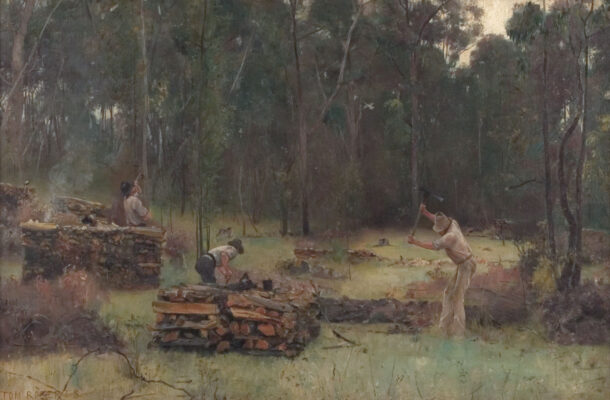The hardscrabble lives of the selectors

This essay should be read in conjunction with my essay on selection – The mystery and legacy of Australia’s immigrant selectors.
In this earlier essay I referred to “detail about the difficulties of living the selection life, the role of the family, the attitude to education, the commercial imperative, farmer adaptation and mechanisation, access to markets, aggregation and transition to sustainable modern agriculture”.
In recognition that detail is important I have written this companion piece.
What is difficult for any of us living today is to fully understand what it was like to live the life of a selector. Also, whilst our family history was prepared nearly three decades ago, it contains very little of this lived experience of selection. The focus of our family history is on what I would call the “statistical facts”. It is a marvellous effort but I yearn for more of the “sweat and the dust” of selection.
So, I have sought help through the literature and especially from two eminent historians Tony Dingle and Charles Fahey who have done extensive research on selection in Victoria. As with the first essay, I have woven into the narrative the limited amount I know of how my great grandparents Maurice and Annie lived their daily lives.
Let us begin.
Roles and responsibilities
Tony Dingle observed:
…… the family became the foundation stone of the selection era. On the farm everyone contributed to the family economy as they had done for countless generations in pre-industrial Europe. Wives were the pivot around which the farm economy revolved. They combined the tasks of child-bearing and rearing (thus creating a future labour supply), food production and preparation, home making and home maintenance.
Although men tackled the hardest physical work, women probably laboured for longer hours and needed to master a wider range of skills. Not the least of these in the earliest years was the ability to improvise. Without even the most elementary equipment “Ma manages to cook a damper pancakes and meat outside”.
Women rarely did fieldwork but the garden and orchard, the fowls and the milking cows were their responsibility. The diet and health of the family depended largely upon what was produced form these sources.
This routine was barely disrupted by the regular birth of children. Unless there were complications a woman would be away from her tasks for little more than a week, during which time relatives, neighbours and sometimes the menfolk, would take over temporarily. For much of her early married life the selector’s wife was either pregnant or breast-feeding a baby while still attending to her varied work.”
Annie was married at 23 and was either pregnant and/or breast-feeding a baby for the next 22 years or so. She had her final baby at the age of 44. Annie was to die in 1917 at the age of 72 having lived a widow for 17 years. By all accounts Annie was a forceful character and probably, by weight of the various anecdotes, the strength behind the family’s quest to be successful selectors. As Dingle has assessed it, the selector experience was one centred around the family and in particular the wife and mother.
Dingle also highlights the importance of children, as they grew older. A carefree infant life was quite truncated:
“Children also had to contribute. Play quickly became work as their physical capacities developed. They picked up sticks and roots grubbed by the plough, ran errands, and fetched and milked the cow, before graduating to more demanding labours as they grew stronger.”
For the O’Kanes both Jerilderie and Terrick Terrick East would have been very difficult as the children were too young to help. However by the time they arrived at Boosey, Mick, PA, Anne, Ned and Tim were doing their bit.
Education and the future
Dingle wrote:
“Some selectors could neither read nor write, but they recognised the value of at least an elementary education for their children. Neighbours lobbied enthusiastically for a local school and sometimes cleared the land and helped to construct the necessary buildings. A school was the mark of a growing community but there was always a conflict between education and the labour needs of the farm. During harvest selectors’ children often missed their lessons.”
Adequate education for children was not always possible but Dingle highlights that selectors often organised community schools. In Brenda Niall’s 2017 biography of her grandmother Agnes Maguire, entitled Can you hear the sea? Agnes describes the rural Catholic school at Burramine where she taught. Most of the O’Kane children attended this school. One of them, Patrick (PA) even gets a direct mention in the book.
This attention to schooling amongst all the challenges the selectors faced indicated a broader view of life than might be expected in the circumstances. The selectors were looking to the future and this meant at least a basic education for their children.
The daily battle with pestilence, plague and disaster
Dingle notes the many hazards faced by selectors – snakes, falling trees, accidents, diseases such as foot-rot, scab and phylloxera and pests such as locusts, caterpillars, rabbits and kangaroos nibbling away young crops and feral plants competing with them. In almost every case the bush sought to recolonise land that had been cleared.
There was also the isolation and distance from medical treatment, bushfires of course, drowning and young children being lost in the bush. On the Northern Victorian plains, drought, bushfires and floods were an on-going risk. It is probable that Madge and her baby would have lived but for this isolation.
Dingle notes that the second half of the 1870s were very dry and that 1880s saw plagues of locusts. Diseases such as rust and dieback and feral plants and animals caused great problems.
During this period Maurice and Annie were attempting to establish themselves at Jerilderie and Terrick Terrick East. It was clearly a highly stressful time and perhaps this contributed to the death of Timothy? We have no evidence either way on this but we can be sure that bronchitis is an outcome not a primary cause of ill health.
The success rate of selectors was not high and in many regions it was less than 50%. Dingle records that the major factors determining success were adequate capital, a large family old enough to work, previous experience in farming, soils, vegetation and climate.
For Maurice and Annie, the early years were clearly very difficult. They were learning how to farm in an alien land and unfamiliar climate but it seems they were made of persistent material.
John Sweeney’s journals
Charles Fahey studied selection in the parishes of Baulkamaugh and Katunga in Northern Victoria. These parishes are only a few kilometres west of Boosey and were of similar climate, terrain, soils and vegetation (temperate grassy woodland). Both Dingle and Fahey draw on the journals of one John Sweeney who selected in Baulkamaugh
Sweeney selected on the same basis as would have the O’Kanes. This was under the terms of The Land Act 1869. This Act required the selector to, as Fahey outlines:
“to enclose their property with a boundary fence, cultivate ten per cent of the holding, build a permanent house and generally make improvements to the extent of £1 per acre. They were also expected to live on site.”
Fahey points out that the terms of selection meant that selectors must “turn a profit”. Financial viability was an immediate and necessary objective for selectors to be successful. In Fahey’s words:
“Under the stringent financial terms of the Act settlers were committed to commercial agriculture; subsistence was not an option.”
“In the early 1860s, and even well into the twentieth century, legislators had planned for a densely populated countryside with self-sufficient yeoman farmers. After more than a decade of experimentation settlers abandoned such dreams and by the 1880s consciously engaged with a new form of agriculture based on broad acres, cash crops and mechanisation. Sweeney and his neighbours in Baulkamaugh-Katunga took part in this agricultural revolution.”
The arrival of mechanisation
Fahey goes on to detail what this meant in terms of the progression of mechanisation from primitive reaping machines requiring considerable labour for binding, stooking and carting to more automated strippers and winnowers.
John Sweeney and his brother Pat were early adopters of mechanisation. They were also conscious of the need to till the soil and to use fallowing for rejuvenation and of the new seeds that performed better in the climate and were more resistant to rust and other diseases. The Sweeneys were carrying out a process of adaptation on a broad front with the outcome being sustainable arable farming. Fahey highlights this as a self-initiated set of measures to achieve resilience in a challenging environment:
“From the early 1890s through until the early twentieth century, plains farmers experienced a number of bad years culminating in the great Federation Drought of 1901-02 (the Federation Drought). Sweeney’s memoir chronicles the difficulties of these years but it also shows that during many of the bad years the new technology permitted crops to be harvested………..
…….Even in 1901-02, a year he never wished to see again, 200 acres produced 1523 bushels of wheat and 15 tons of hay.”
Other adaptation and challenges
This process of adaptation was to continue into the 20th Century. It saw the selectors, that had survived the early difficult years, become highly innovative commercial broad-acre mixed cropping and animal farmers. This had worldwide consequences with Australia rapidly becoming an important granary supplying Europe, particularly the British Isles.
The task of clearing the woodland, whilst not of the same order as say in South Gippsland, was arduous and continuous. Sweeney could only gradually expand his cropped land. He initially cropped only 12 acres but increased this over three years to 60 acres.
Fencing was a major requirement and for Sweeney, with little access to capital, it consisted of “chock and log” fences. These fences were made from the timber cleared from the property. Early dwellings were also made from this timber.
Sweeney experienced difficulties with rust, climate variability and declining yields as the virgin soil became depleted.
The coming of the railroads, aggregation and evolution
Rail access was critical for commercial viability. Selectors campaigned for and were successful in having rail extensions across much of Northern Victoria by the end of the 19th Century. By 1889, the Sweeneys could deliver to nearby Katunga. By 1899 the O’Kanes had a choice of railheads at either Yarrawonga or Katamatite.
Fahey highlighted that whilst there was a high level of “selling out”, the selector fabric was evolving into something that would prove to be sustainable long term. Those selling out were selling to existing selectors who could see the advantage of and were able to achieve larger farming acreages. The Sweeneys took the opportunity of enlargement.
Dingle also highlights the importance of enlarging the size of the farm:
“Despite these hazards selectors were eager to seize any opportunity to enlarge their farms beyond the maximum 320 acres they were allowed to select. “we are all so ambitious that we want to get as much land as we can’, explained one selector, but the real reason was that larger properties were more profitable and less risky. Soils could be rested, machinery used more efficiently. Extra acreage allowed stock to be combined with crops to lessen the dependence on wheat.
Selectors were as willing as squatters to evade the provisions and intentions of the Acts in order to increase the size of their farms. Members of the same family selected adjacent blocks and later combined them into family holdings. Although wives could not select children over eighteen years of age were allowed to do so. They were dummying. Sometimes relatives or friends selected close to each other and shared a common pool of equipment and horses without ever formally amalgamating their land.”
Dingle also writes of the emergence of successful farmers referred to as “boss cockies” who managed to assemble several thousand acres. He notes that the reformers disliked this trend as it was contrary to the modest yeoman vision of freehold farming. Dingle argues that the yeoman vision proved unrealistic. He highlights that the selection process was evolutionary and that the market was being created for the buying and selling of properties that either provided capital for a larger farm elsewhere or for the seller to engage in some other enterprise.
Whilst having a slightly different perspective, Annie (now on her own) was determined to assist her remaining boys to become farmers too. Sr. Mary Camillus who lived with the family as a youngster wrote:
“Nan (Annie) carried on with the help of the remaining children. Michael, prior to his father’s death had been given “Hill Plain” which he had to pay off and Ned had taken on “Clearys”.
By the time of her death in 1917, Nan had paid deposits on land for the remaining sons.”
The outcome
Some might say that the proof of the pudding is in the eating. Dingle highlights the outcome of all these transitions in the process of selection. He records that wheat production in Victoria increased from thirty-four million bushels during the decade 1861 to 1870 to 111 million bushels during the decade 1881 to 1890 and then to 200 million bushels between 1901 to 1911. This explosion in wheat production was accompanied by similar growth in the production of other grains and also butter. More was to follow with the beginning of irrigation along the River Murray.
Australia went from barely able to feed itself to a major food exporter. Victoria was, briefly, “the granary of the continent”. Most of this grain production was north of the Divide or in the Wimmera and the Mallee. Most of this can be assigned as a legacy of the selectors.
Bernie O’Kane has a background in urban infrastructure investigation, planning, design and construction. He has worked in both the public and private sectors in Australia, Hong Kong, Malaysia, Indonesia and Vietnam, and has a Masters in environmental planning and water resources from Stanford University.










